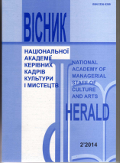POST-IMPRESSIONISM COLORISM IN 1960-1980-S IN UKRAINE: empirical experience generalization methods
DOI:
https://doi.org/10.32461/2226-3209.2.2014.137974Keywords:
empirical experience, impression, generalization, method post-impressionism, symbol, metaphorAbstract
The article deals with individual methods of artistic generalization used in 1960-1980s in Ukrainian postimpressionism colorism. Since the re-evaluation of empirical experience is connected with subjective worldview, through which the transformation of the natural source takes place in the artist's consciousness, this triggered the problem of existence of individual methods of graphic correction. These methods are a systematized set of successive steps taken by artists in order to achieve their creative goal – the transformation of nature to a state of generalized metaphor. We identified four categories of graphic correction methods.
The author's aim is to examine the specifics of graphic correction methods. The differing organization of the process of artistic activity results in the reframing of subjective reality. It was found that in different genres of work the same colorist used different methods of graphic correction at the same time. Therefore, there emerged a need to define the prerequisites necessary to implement the required methods of correction and to classify them Classification of graphic correction methods was carried through an analysis of art works by famous Ukrainian artists from the museum collections of the National Art Museum of Ukraine, Andrey Sheptytsky National Museum (Lviv), József Boksay Transcarpathian Regional Art Museum, the Memorial museum house of folk artist of Ukraine Andriy Kotska, Uzhgorod memorial museum room of the Honored Artist of USSR Gavrylo Martynovych Gluk, Odessa Art Museum, the National Museum in Warsaw.
It was found that the method of creating images purely from memory was common practice for such Carpathian colorists as Oleg Garagonych (1952-2014), Gavrylo Gluk (1912–1983), Ernest Kontratovych (1912-2009), Anton Shepa and in activities of Kyiv artist Tetiana Yablonska (1917–2005). As this method, in terms of its specificity, relied solely on intuition and reflection, we defined it as informative-reflectory.
The basis for another method was that to create a future metaphor the artist used pre-made sketches instead of wildlife or own memories of it. This was the manner of the Transcarpathian artist Andriy Kotska. Since all parameters of an artistic image are identified and not subject to radical changes during new interpretation, we described this method as reproductive-pragmatic.
The next method emerged solely from the creative impulse. To create an artistic metaphor, the colorist needed emotional distress, exacerbated in contact with natural elements, thus revealing the pictorial instinct of the artist. This method was used by such Transcarpathian masters as Ernest Kontratovych, Gavrylo Gluk, Volodymyr Mykyta and their colleagues from Lviv – Volodymyr Patyk, Roman Selsky (1903-1990), Oleksa Shatkivskyy (1908-1979). Since the artist did not anticipate any certain end result, which changed dynamically during creation, we identified this method as impulsive-irrational.
The last method found in the practice of Ukrainian post-impressionism adherents, resembled the previously described ones in terms of approaches to the creative process organization. However, the crucial difference is that the artist did not seek to blend with the natural element, but rather distanced himself from it. As Arthur Schopenhauer said, "The artist himself is nature". In our case, "the artist's nature" contrasted its own harmony to the chaos of elemental chance. The above method of intellectual revaluation of reality was used by Paul Cezanne and by the specifics of the mental dominant is traditionally recognized as inductive. We found the use of the inductive method of correction in the creative works by Odesa colorist Yuriy Yegorov.
During the study, we came to a conclusion that the symbolic transcription of Existence entailed the leveling of the subject and contributed to further compaction of artistic content. The artists' desire to overcome outer illusory of objects and approach to their covert nature required new, in each case individual methods of artistic process, which we identified as graphic correction methods, and systematized into four categories by specifics of subjective and rational expediency. The first method, simply reproducing an image in memory, was identified as informative-reflectory; the second, based on existing preliminary sketches, – as reproductive-pragmatic; the method of artistic generalization implemented under the influence of a natural element – as impulsive-irrational, the method of intellectual conclusions from contact with nature – as inductive. The analyzed empirical experience generalization methods became a leading tool in the creation of post-impressionism improvisations in 1950-1980-s inUkraine.
Downloads
Published
Issue
Section
License
Authors who publish with this journal agree to the following terms:
1. Authors retain copyright and grant the journal right of first publication with the work simultaneously licensed under a Creative Commons Attribution License that allows others to share the work with an acknowledgement of the work's authorship and initial publication in this journal.
2. Authors are able to enter into separate, additional contractual arrangements for the non-exclusive distribution of the journal's published version of the work (e.g., post it to an institutional repository or publish it in a book), with an acknowledgement of its initial publication in this journal.
3. Authors are permitted and encouraged to post their work online (e.g., in institutional repositories or on their website) prior to and during the submission process, as it can lead to productive exchanges, as well as earlier and greater citation of published work (See The Effect of Open Access).


